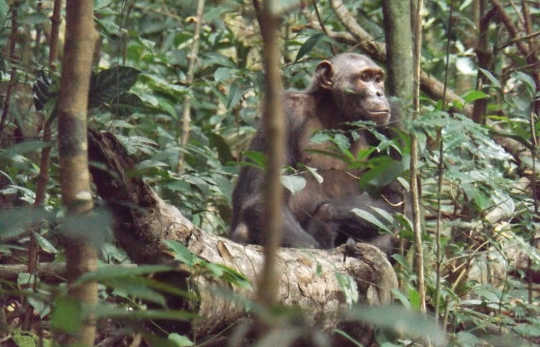
The chimpanzees were as successful at extracting the honey as the honey badgers. MPI EVA / Loango Chimpanzee Project- Anne-Céline Granjon
Chimpanzees are the closest living relatives to humans. Because of this they can offer invaluable insights into understanding the evolutionary roots of how humans developed their cognitive and technological abilities. ![]()
Years of data taken from studies conducted on wild apes suggests that chimpanzees could have something similar to what we call “culture” in humans. Biologists define “culture” as a set of behaviors – such as dietary habits, technical solutions, and communication systems – that individuals of one group share and that are distinguishable between groups. These behaviors are passed on from one individual to another not genetically, but socially by, for example, observing other individuals. These findings have led to a lively debate about “culture” in animals.
One way of understanding the evolution of “culture” among animals is by documenting and analyzing the behavior of wild chimpanzees.
We have completed a study that adds to this body of knowledge. We used camera traps (a non-invasive approach) to monitor the behavior of members of a community of chimpanzees in the forests of Loango National Park in Gabon. What we caught on camera was that they performed a specific technique to extract underground bee nests.
We were able to directly observe how chimpanzees access a high quality food resource that would otherwise be inaccessible. Our research confirmed earlier observations that chimpanzees use wooden tools to dig out the bee nests and access the honey. This allowed them to achieve similar levels of success as other, more skilled, diggers such as honey badgers and forest elephants, with whom they compete for honey.
Our study adds new knowledge to understanding the behavioral ecology of three species that inhabit a wide range of habitats across Africa.
What the cameras captured
Loango National Park provides an exceptional location to study chimpanzees. The park is made up of a unique combination of coastal forest, mangroves, savannas patches, rain-forest and swamps. The local fauna reflects the richness of the habitat, and includes buffaloes, forest elephants, red river hogs, monkeys, duikers and hippos.
The Loango Ape project was initiated in 2005 to investigate various aspects of the behavioral ecology of central African chimpanzees and western lowland gorillas. Both species inhabit the same area at this unique field site.
Before the cameras were set up, researchers started by looking for signs of apes. They soon came across wooden sticks next to holes dug into the ground, often associated with honeycombs. To expert eyes the sticks suggested that they were being used to extract honey, possibly by chimpanzees.
Honey is an extremely valuable food source for animals because it has a high concentration of sugar and other natural elements.
Thanks to the non-invasive approach we used, it soon became clear that chimpanzees were not the only consumers of the honey from the underground bee nests. It turned out that they had to compete for this resource with honey badgers and, surprisingly, forest elephants.
Competition for the honey
Previous studies carried out at the same site showed that chimpanzees could be excluded from certain feeding areas because of competition with other species, particularly elephants. This prompted us to take a closer look at the interactions among the apes and the other consumers of the underground bee nests.
We found that chimpanzees weren’t affected by the previous visits of elephants, but that they refrained from digging after honey badger visited a bee nest. Honey badgers are known to be fierce fighters, which could explain the chimpanzees behavior. In fact, this strategy could help chimpanzees to prevent risky encounters with this competitor.
Another challenge for the apes is that the honey is buried deep in the ground – some nests were a meter underground, giving honey badgers and elephants an advantage. Honey badgers are well adapted to digging while elephants are physically strong. Despite this, the chimpanzees we watched were as successful at extracting the honey as the honey badgers, likely thanks to the tools they used which improved their ability to dig.
The use of tools therefore helped chimpanzees access a high quality food resource they would otherwise have found inaccessible.
Overall, our study provided new, fascinating observations about the behavior of wild chimpanzees. We showed that chimpanzees can apply a complex technique using tools to access a hidden resource. We also showed that they changed their behavior to avoid risks, such as encountering potentially dangerous competitors.
These results provide more evidence about the range of technological and behavioral strategies that chimpanzees are able to perform in their natural environment.
About the Author
Vittoria Estienne, Doctoral student Department of Primatology, Max Planck Institute
This article was originally published on The Conversation. Read the original article.
Related Books
at InnerSelf Market and Amazon























